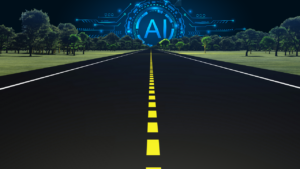Every week more discussions about the importance of digital transformation take place in business settings. Leonard Lee, founder and Managing Director of neXt Curve, calls this obsession with digital transformation a “mania.” He writes, “In business circles, it is common to hear strategy consultants, analysts, and academics pontificate that companies need to become a ‘digital business’ to compete and survive in this age of ‘digital’. So, when and how did all this digital business mania begin?”[1] He posits that it began around a decade ago. And, at the time, he notes, “Artificial intelligence was not yet a thing.” As a result, the digital enterprise vision failed to capture the future business environment as it is now emerging.
Lee believes that companies just starting their digital transformation journey should broaden their aspirations. He insists they need to move beyond becoming digital enterprises to become autonomous intelligent enterprises. The road to becoming an autonomous intelligent enterprise obviously passes through the digital enterprise mile marker; however, lingering there could prove costly as competitors continue their journey. Tech journalist George Lawton calls the continuing journey an automation revolution. He explains, “Enterprises are in the early phases of a revolution whose mission is to make more kinds of business systems, equipment and processes perform with less human intervention. This autonomous revolution is rapidly moving from one-off experiments to a collective effort to build digital fabrics that can keep up with the rapid pace of change in supply chains, geopolitics, and the environment. The promise? An increase in efficiency, scalability and profitability on a level previously unknown.”[2]
The Road to the Autonomous Intelligent Enterprise
As noted above, the road to becoming a digital enterprise is the same road that leads to becoming an autonomous intelligent enterprise — and that road is paved with data supported by artificial intelligence (AI). Author and IT expert Joe McKendrick asks, “Has the autonomous enterprise finally arrived?”[3] For Lee, the answer to McKendrick’s question is “almost.” He writes, “I would argue that we are at the cusp of the era of autonomous today. … I have dubbed the phase beyond digital business the ‘autonomous enterprise’.” Lee believes the convergence of AI, cloud computing, and 5G/6G, and other advanced wireless communications technologies are the enablers of the autonomous intelligent enterprise. McKendrick reminds us, however, “To reach this goal, AI needs to be supercharged with intelligent data supply chains.”
AI expert and founder of Going Global Ventures Mark Minevich agrees with Lee that technology has paved the way to the autonomous intelligent enterprise. He explains, “Every significant technology disruption has led to fundamental changes in how businesses are run, what products and services are sold, and how customers engage with enterprises. … Each technology wave has brought tremendous opportunity to those who understand how to leverage these new capabilities. This time around is no different: businesses that master this digitization trend will better serve customers, lower costs and drive revenue.”[4] In addition to the technologies already mentioned by Lee, Minevich adds natural language processing (NLP), the Internet of Things (IoT), and autonomic systems. He insists, “These disruptive technologies can help companies acquire and retain customers, create new business models and drive revenue growth — but only if they are implemented correctly.”
Minevich insists that the road to the autonomous intelligence enterprise begins with hyperautomation. He explains, “Hyperautomation is the process of automating the entire business ecosystem, with collaboration between machines and humans. This platform focuses on driving operational excellence with digital technologies like robotic process automation (RPA) and artificial intelligence.” He adds, “Executives should stop seeing automation as composed of siloed units and independent elements. Instead, automation technologies should become pieces of the same puzzle that different areas of the enterprise leverage at the same time. Moreover, as digital technologies such as AI and RPA continue to mature, we’ll see more intelligent automation — or ‘hyperautomation’ — that provides context around the tasks being completed. It’s a business-driven framework for businesses and IT to identify, vet, and automate enterprise operations as possible.”
R “Ray” Wang, Principal Analyst and founder at Constellation Research, suggests there are five levels of autonomous enterprises.[5] The first level is basic automation. At this level, humans guide manual steps but basic process automation tools like Business Process Management (BPM), manual instrumentation and control, and intelligent workflow automation are also involved. The second level is human-directed automation. At this level, humans direct major decisions while minor decisions are automated. Technologies involved at this level include: RPA, process-mining tools, journey-orchestration tools, machine-learning algorithms, and NLP. The third level is machine intervention automation. At this level, Wang indicates that humans are on standby, but can be hands-off for periods of time. Technologies involved at this level include: Cognitive applications, neural networks, GANS models, contextual decisions, and next-best actions. Level 4 is fully autonomous. At this level machines are fully automated. Technologies include: AI-driven smart services, full automation, self-learning, self-healing, and self-securing technologies. The fifth level of autonomous enterprise maturity takes things a step further and makes humans optional.
Wang admits that to achieve Level 5, artificial general intelligence (i.e., full sentience) is required. That’s a big leap. If it happens, he notes, technologies will include fully autonomous sentience that empowers precision decisions at scale. Even though sentient AI remains aspirational, when people hear the term “autonomous” they jump to the conclusion that humans are eliminated from the picture. That’s is currently a myth. As Minevich explains, “To stay competitive, businesses must move fast. Enterprise officials may begin by assessing their automation maturity to ensure that the company automates intelligently and appropriately for their enterprise. … Organizations must start preparing by developing the skills and competencies that their employees need to work in a digital workplace environment where AI agents and automated systems collaborate to provide customers with an exceptional end-to-end service experience.”
Concluding Thoughts
Wang concludes, “Pioneering work with cognitive applications shows exponential progress and may achieve Level 4 status by as early as 2023. This means organizations will have to rethink how they work with their transactional applications. There will also be a major impact in how businesses should approach future data-driven digital networks and distributed compute and storage environments. For most enterprises, it’s clear that the future will be autonomous.” I agree with Wang. That’s why Enterra Solutions® continues to advance Autonomous Decision Science™ (ADS®). ADS will play a significant role at both Levels 3 and 4. Author and technology evangelist Sarah Burnett asserts, “No organization can afford to ignore what is going on. It’s such an exciting time in technology [as] organizations navigate their way towards autonomous enterprises of the future.”[6]
Footnotes
[1] Leonard Lee, “Understanding and Executing on the Autonomous Enterprise,” Acceleration Economy Network, 21 March 2022.
[2] George Lawton, “The push is on to build the autonomous enterprise,” TechTarget, 10 June 2022.
[3] Joe McKendrick, “Artificial Intelligence Paves a Path to the Autonomous Enterprise, with a Caveat,” RT Insights, 29 April 2022.
[4] Mark Minevich, “How The Path From Digital Automation To Autonomy Will Disrupt Enterprise In 2022,” Forbes, 4 February 2022.
[5] R “Ray” Wang, “Five Levels That Will Define the Future of Autonomous Enterprises,” IBM, 1 July 2021.
[6] Sarah Burnett, “The Autonomous Enterprise – Powered by AI,” BCS, 28 January 2022.





